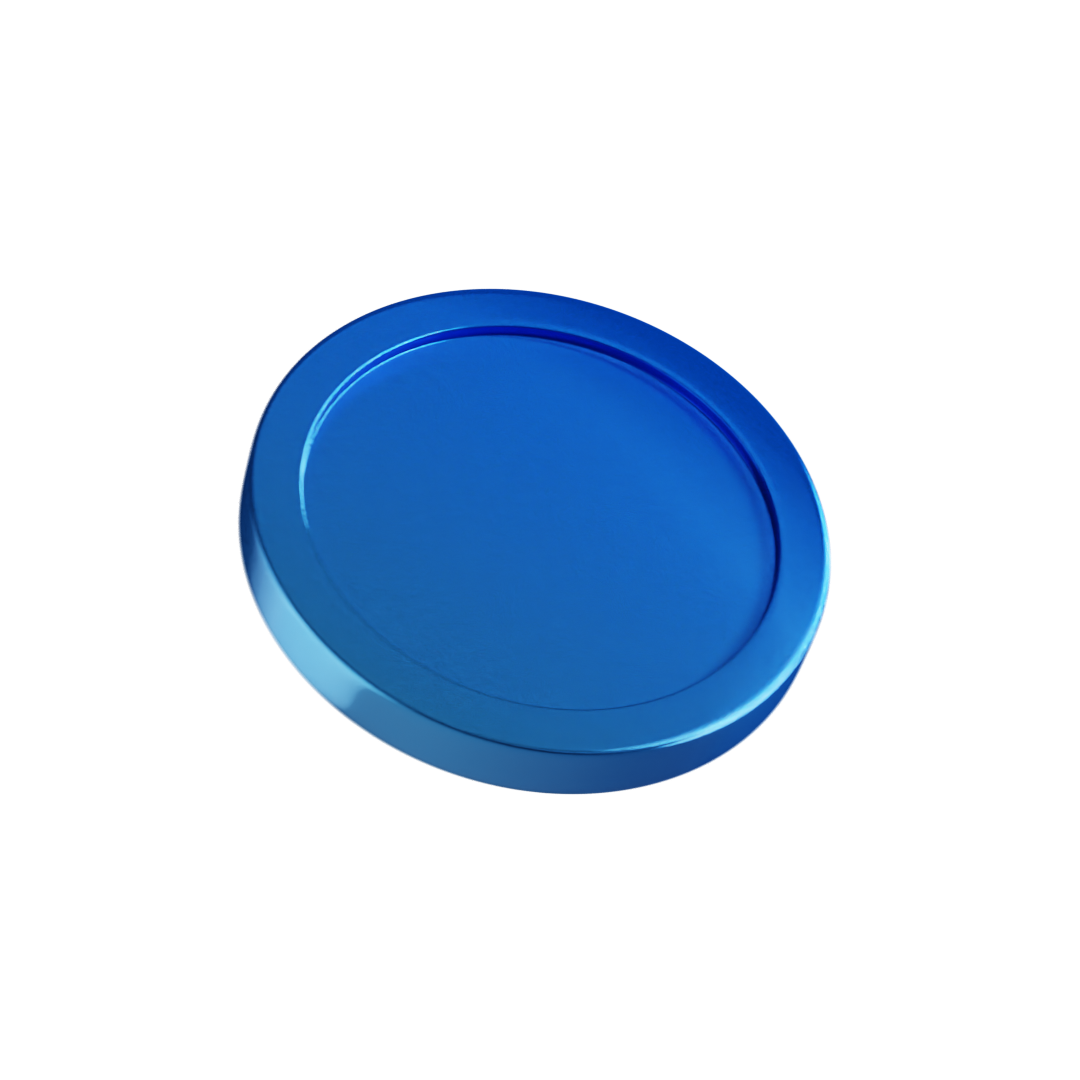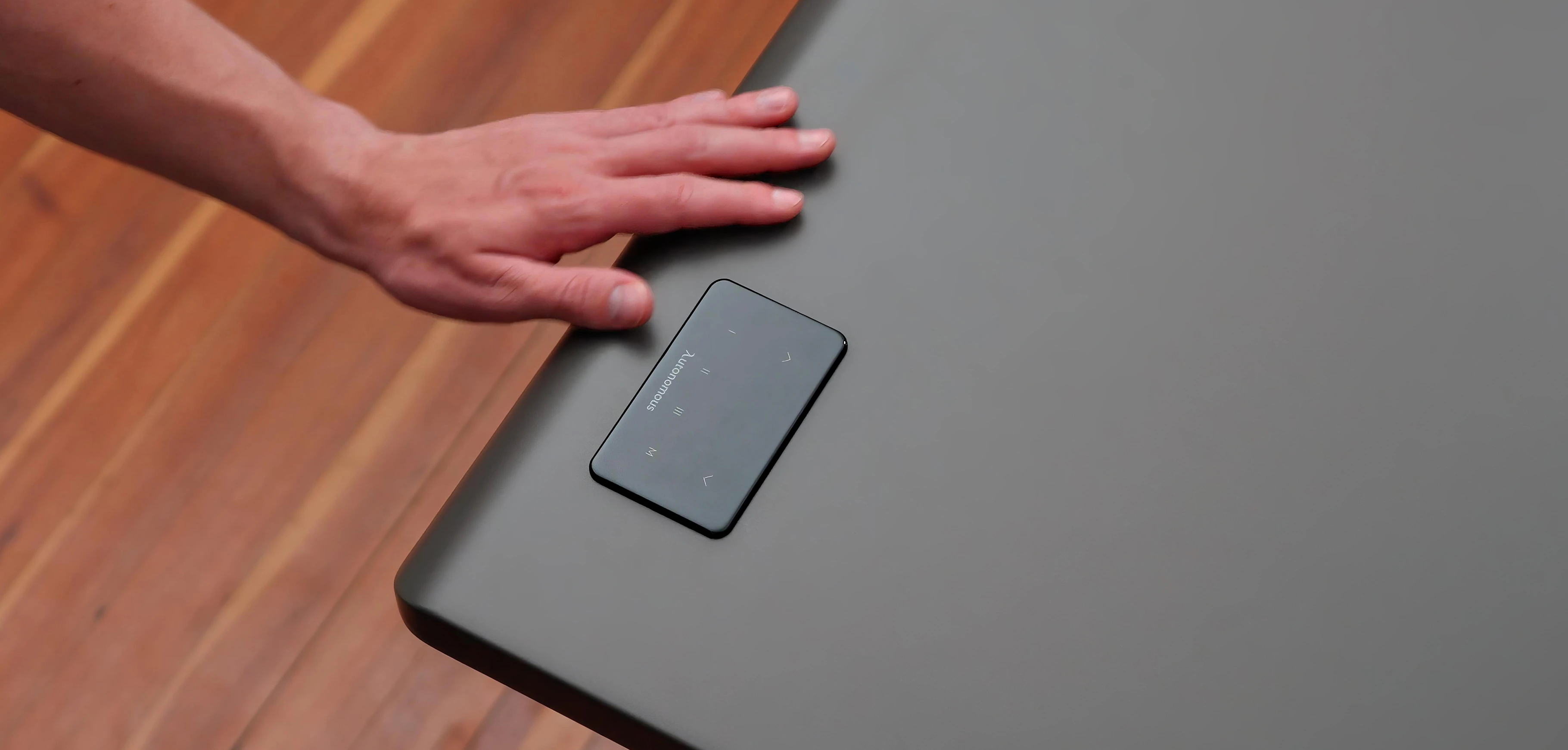SmartDesk 5
Superior Coating Evolution
The development of powder coating in SmartDesk 5’s quality and user experience
Is your standing desk secretly making work harder?
Have you ever touched your standing desk and felt a rough, sticky surface—or noticed the edges peeling? Or perhaps you've hit your arm or leg when resting or leaning to relax after a long workday? While these might seem like small issues, they can quietly affect how you work, how comfortable you feel, and even your health.
That’s why, when designing the SmartDesk 5, we wanted users to experience a constant chain of comfort and ergonomics, starting from the high-quality desk surface all the way to the frame design. We focused on built-in features (like the keypad and accessories) and C-shaped legs pushed behind the desk to ensure nothing interferes with your body movement or setup preferences.
But the most challenging part was—getting the desk surface right—something our customers always mention as their first impression right after unboxing and assembling the desk. If SmartDesk 5 failed to impress them with its surface quality, every other features would fall short. After testing, evaluating, and gathering feedback, we finally succeeded in developing a surface using epoxy–polyester powder coating on high-density fiberboard (HDF).
Desks with weak coatings can easily scratch, absorb moisture, and wear down quickly, leading to chipped edges, uneven surfaces, and uncomfortable spots over time. Some coatings even release strong smells or harmful chemicals into the air—things you definitely don’t want in a space where you spend hours each day. That’s why a strong, reliable coating like SmartDesk 5’s Interpon 700 epoxy–polyester powder makes all the difference. It creates a smoother, stronger, and longer-lasting surface, also keeps your space cleaner and safer—something traditional paint just can’t do. This article walks through what we learned, how we did it, and why it matters for SmartDesk 5 daily users.
What is Interpon 700 epoxy-polyester powder coating?
Powder coatings start as a dry powder sprayed onto a surface using an electrostatic process. Then, the surface is heated in an oven, which makes the powder melt into a smooth, hard layer that protects the desk from scratches, water, and damage. They are popular for their eco-friendliness because they emit almost no harmful gases (also known as VOCs, or volatile organic compounds).
This study explains why we use Interpon 700 epoxy–polyester powder coating on SmartDesk 5’s HDF surface instead of common options like melamine laminates or polyurethane matte sealers. Thanks to its excellent durability, consistent finish, and low environmental impact, the Interpon 700 coating maintains a smooth, long-lasting surface. A high-quality finish leads to a more comfortable and satisfying workspace, which can help reduce stress, increase dopamine release, and improve productivity. With its strong technical performance and positive user feedback, SmartDesk 5 is a great choice for both home and office work within its price range.
How does a well-designed desk impact productivity?
This part shows how a well-designed desk with a smooth, matte finish and durable materials can really boost work productivity. A great workspace isn’t just about looking nice; it should promote comfort, mental & physical support, and work efficiency at the same time.
Imagine stepping into an aesthetic office where all the furniture looks neat and inviting. A nice-looking desk creates a feeling of order and calm. This happy atmosphere helps lower stress and brings satisfaction (Smith et al., 2017). When people feel good, their bodies naturally reduce stress hormones like cortisol and release feel-good chemicals like dopamine, which in turn helps them focus and think clearly (Johnson & Lee, 2018).
It isn’t just about the appearance. Ergonomic features—such as adjustable desk heights and sturdy lifts—play a key role in this dynamic. When a desk is designed to fit a person’s needs, they’re less likely to experience aches or fatigue. This physical comfort helps them stay focused on tasks, boosts motivation, and leads to better productivity (Davis et al., 2019).
In addition, a well-designed desk can help reduce stress, increase dopamine release, and improve productivity. With its strong technical performance and positive user feedback, SmartDesk 5 is a great choice for both home and office work within its price range.
To back up these ideas, our study uses a mixed-methods approach. We ask SmartDesk 5 users to fill out surveys about their feelings and satisfaction with their work environment. Ergonomic tests are also performed to see how well the desk supports the body, and productivity data are collected to show how these benefits add up to improved work performance.
How does the combination of powder coating & HDF wood evolve?
We wanted to build a desk that looks great and lasts a long time. In our early tests, we tried different finishing methods.
First, we tried using UV-cured paint on medium-density fiberboard (MDF).
Although the paint dried very fast thanks to the UV light, MDF proved to be a tricky material to work with. MDF is soft and full of tiny holes, so the paint soaked in unevenly, causing it to lose its stickiness and peel off later. The finish was less smooth and durable than we needed.
Then, we tried using melamine on HDF.
Although it looked smooth and shiny at first, the edges easily cracked and chipped off when the desk got bumped or moved because melamine is a bit fragile. So, the finish couldn’t handle small stresses as we needed it to.
After some other tests, we chose to use a powder coating—specifically, Interpon 700 epoxy–polyester powder coating—on high-density fiberboard (HDF).
HDF serves as the ideal base for Interpon 700 powder coating. Its stable, even surface allows the powder coating to bond perfectly, resulting in a smooth, long-lasting matte finish that resists scratches, water, and temperature changes while meeting environmental standards. In contrast, MDF is softer and more porous, leading to uneven adhesion and peeling when used with finishes like UV-cured coatings, and melamine, although initially smooth, tends to crack and chip at the edges with even minor bumps. This combination of HDF with powder coating clearly outperforms other options, making it the perfect choice for the SmartDesk 5.
To apply the coating, the HDF panels are first cleaned and sanded to ensure the powder adheres well. Then, using a high-precision electrostatic spraying method, the Interpon 700 powder is evenly applied over the entire surface. The curing step in the oven locks the finish in place, resulting in a tough, smooth surface.
Further tests—such as adhesion, impact, and environmental resistance evaluations—have shown that the powder coating on HDF outperforms other mixtures. The finish remains smooth, strong, and attractive even under everyday use and changing conditions, making it a reliable and eco-friendly choice for the SmartDesk 5.
Is powder coating really outstanding over other materials?
Powder coating delivers outstanding performance on wooden desktops in terms of durability, finish, and eco-friendliness. Let’s look at how it compares to common paint in furniture production.
What is Traditional Paint?
They are liquid coatings that contain solvents, pigments, resins, and additives, commonly found in consumer-grade furniture products. Common examples include oil-based paints and water-based paints.
Superior Finish and Durability
- Scratch Resistance:
- Compared to traditional paints, powder coating stands out for its superior resistance to damage—such as scratches, rust, and everyday wear—because it forms a stronger, more durable bond during the curing process. This bond creates a 3D network of molecules, making it much harder for the coating to scratch or chip.
- If a traditional paint shows damage at an average scratch force of 10 N, powder coating is proved to withstand up to 12 N—20% better protection.
- Impact Resistance: Powder coating has excellent impact resistance. This is backed by the fact that powder coatings can endure impact forces of 30 kg.cm. To compare:
- For traditional paint, the impact resistance might withstand forces of 20 kg.cm. Powder coating, however, can withstand 30 kg.cm. In terms of energy, Impact Resistance (Energy) = Force × Distance. So:
- The increase in energy resistance from 0.2 J to 0.3 J means 50% better impact resistance with powder coating.
- UV and Fade Resistance: Traditional liquid coatings begin to fade or degrade after 1 year of exposure to UV rays. Powder coatings, however, stay intact for up to 5 years, thanks to their better UV stability.
- UV Resistance Comparison: Traditional paints degrade at a rate of 0.1% per month, meaning after 1 year (12 months), about 12% of the color fades. Powder coatings degrade at only 0.02% per month, resulting in a fade of less than 0.25% after 12 months—a 48 times lower degradation rate.
Long-Lasting Protection
Powder coating’s protective abilities go beyond surface looks and are scientifically proven to offer much better protection
- Corrosion Resistance: The protection against rust and corrosion is critical, especially in humid or high-contact environments
- Salt Spray Test: Traditional paints fail after 100 hours of salt spray testing, whereas powder coatings can last up to 500 hours without showing any significant corrosion. The corrosion rate (r) can be measured using the equation:
Where:
- 𝐴 = area exposed to corrosion (in cm²),
- 𝑡 = time until corrosion occurs (in hours).
- After 500 hours, the powder coating has a corrosion rate of 0.05 cm²/hour compared to 0.1 cm²/hour for traditional coatings, proving that powder coatings last twice as long.
- Eco-Friendliness: Powder coating is a greener option compared to traditional paints, reducing harmful emissions and waste.
- No Solvents: Traditional paints often contain volatile organic compounds (VOCs), which pollute the air. Powder coatings are VOC-free and do not release harmful chemicals into the environment.
- Energy Efficiency: Traditional paint drying times can extend to several hours due to the evaporation of solvents. Powder coating cures in just 15-20 minutes at a temperature of 180°C, consuming less energy.
- Energy Efficiency Formula: Energy Consumption = Power × Time
- A traditional liquid coating may require 3 hours of energy at 1 kW to dry, consuming 3 kWh. Powder coating, however, takes only 0.33 hours at 2 kW, consuming only 0.66 kWh—more than 4 times less energy.
Conclusion
Powder coating not only enhances the SmartDesk 5’s appearance and functionality, but it also provides superior protection and is more eco-friendly compared to traditional paints. From impact resistance to UV stability and corrosion prevention, powder coating outperforms the typical liquid paints by a wide margin, making it the ideal choice for a long-lasting, durable, and sustainable finish.
Results
SmartDesk 5 makes a big difference in both its appearance and how users experience it. The smooth, durable finish keeps the desk looking clean and modern, even after a lot of use.
Better Look: The powder coating gives the SmartDesk 5 a sleek, smooth finish that resists scratches and stays looking fresh longer. Users have reported that the desk maintains its attractive appearance even after daily use, including accidents like spilled coffee or placing hot devices on the surface.
Improved Comfort: With its smooth surface and durable protective layer, users find the desk more comfortable to work on. The mouse glides smoothly and precisely, while the armrests are protected. There's no discomfort from hitting the desk with arms or legs when leaning or resting, reducing distractions and helping users stay focused.
Increased Productivity: A well-built desk means fewer issues with damage or discomfort. This allows users to use it daily for extended hours, leading to improved overall productivity.
Discussion
Adhesion & Compatibility Challenges with Wood Substrates
While powder coating excels on metal, applying it to wood-like HDF requires optimized surface preparation and curing parameters. Any inconsistency in surface density or oven temperature can affect bonding strength and finish quality.
Scaling Production While Maintaining Consistency
Powder coatings like Interpon 700 offer excellent repeatability, but color variation between batches and potential “marble effects” from reclaim powder can pose risks in large-scale production. Quality control during fluidization and curing must be tightly monitored.
.svg)


.webp)



